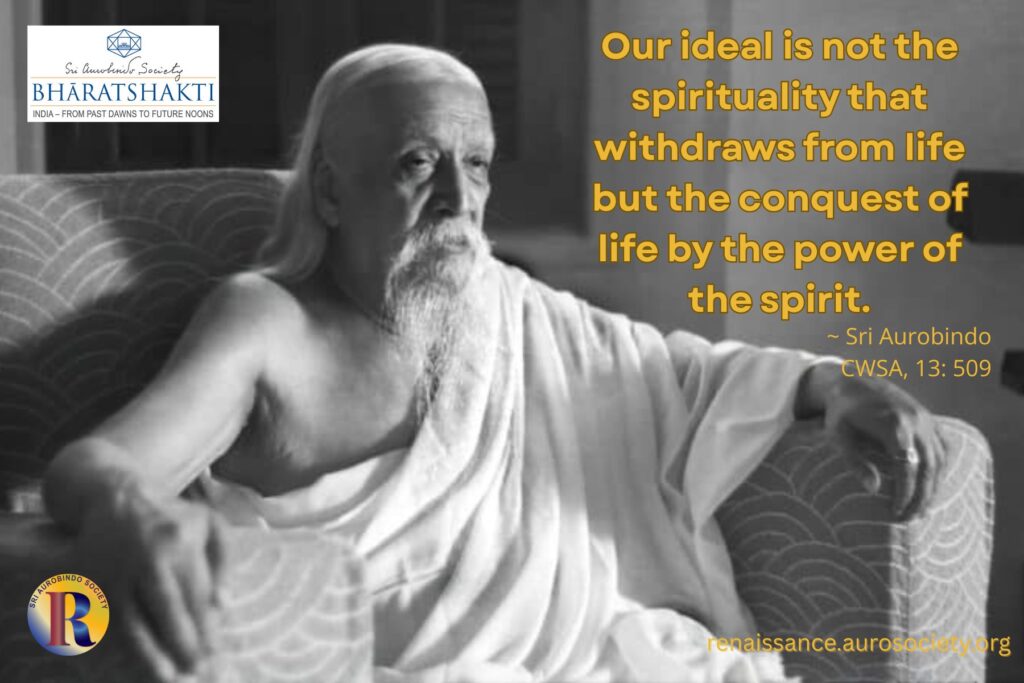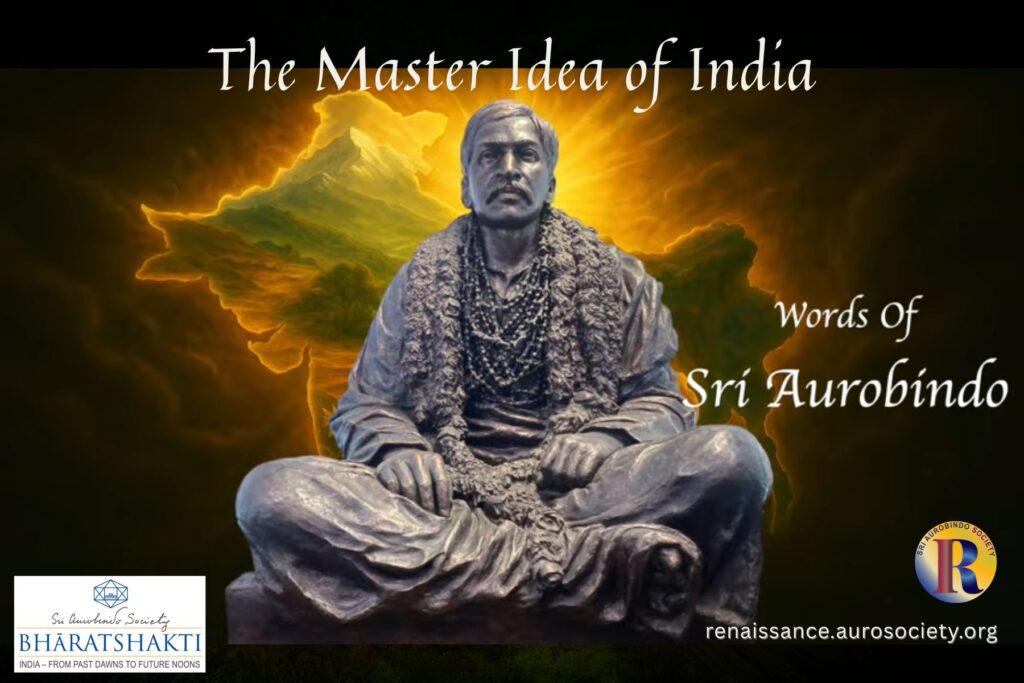Vol. III, Issue 7
Author: Prema Nandkumar
Editor’s note: With this issue we begin serialising selected essays of Prema Nandkumar focusing on Indian literature in the light of Sri Aurobindo. We begin with her essay on the two epics – Ramayana and Mahabharata. As these are long essays, we will present each in several parts. These were first published in Sri Aurobindo Circle in 1980s.
The first essay from the 1984 issue Sri Aurobindo Circle published by Sri Aurobindo Society provides an introduction and focuses on the Ramayana. We present part 1 of the essay here, with a few formatting revisions done for the digital presentation.

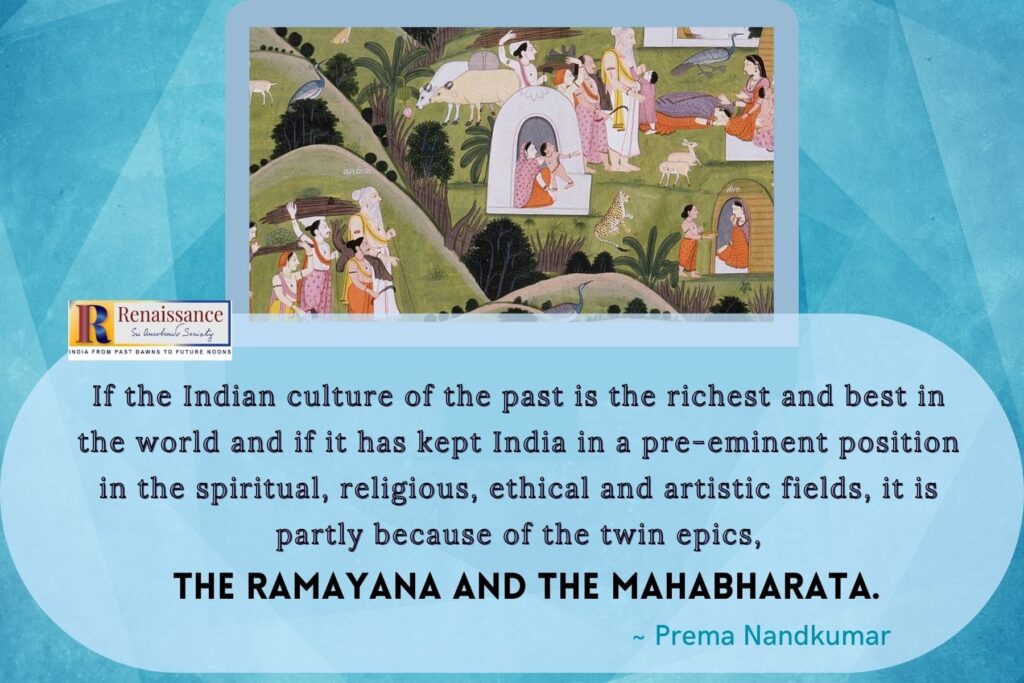
“Ensouled Image of a Great Culture”
In the historical development of Indian culture, after the sublime utterances of the Veda and the spiritual transcendences achieved by the Upanishads comes the Heroic Age.
The Vedas and the Upanishads may not be a day-to-day reality for the common man in India. But the Ramayana and the Mahabharata dating back to several centuries before the advent of Christ continue to affect his thinking. He still tries to fashion his life according to the ideals expressed by Valmiki and Vyasa.
If the Indian culture of the past is the richest and best in the world and if it has kept India in a pre-eminent position in the spiritual, religious, ethical and artistic fields, it is partly because of the twin epics, the Ramayana and the Mahabharata.
These epics are not rough, oral sagas exulting over blood spilt in battle-victories; nor are they mere conglomerations of sub-human and super-human mythology. They are, in the words of Sri Aurobindo,
. . . a highly artistic representation of intimate significances of life, the living presentment of a strong and noble thinking, a developed ethical and aesthetic mind and a high social and political ideal, the ensouled image of a great culture.
~ CWSA, Vol. 20, p. 353
As rich in freshness of life but immeasurably more profound and evolved in thought and substance than the Greek, as advanced in maturity of culture but more vigorous and vital and young in strength than the Latin epic poetry, the Indian epic poems were fashioned to serve a greater and completer national and cultural function and that they should have been received and absorbed by both the high and the low, the cultured and the masses and remained through twenty centuries an intimate and formative part of the life of the whole nation is of itself the strongest possible evidence of the greatness and fineness of this ancient Indian culture.
The Veda vangmaya and the Upanisad vangmaya had yielded place to the kavya vangmaya in deference to the command of the Time Spirit. What had been seen in the illumined recesses of the seer’s heart in the Vedic Age had been analysed clinically by the teachers and the students together in the Upanishadic times. The Taittiriya Upanishad makes this clear in the prayer for mutual good-feeling between master and disciple.
Hari OM. Together may He protect us, together may He possess us, together may we make unto us strength and virility. May our study be full to us of light and power. May we never hate. OM! Peace, peace, peace.
~ Translation by Sri Aurobindo, CWSA, Vol. 18, p. 216
Now the time had come to see these Vedic-Upanishadic radiances influencing the life of the people.
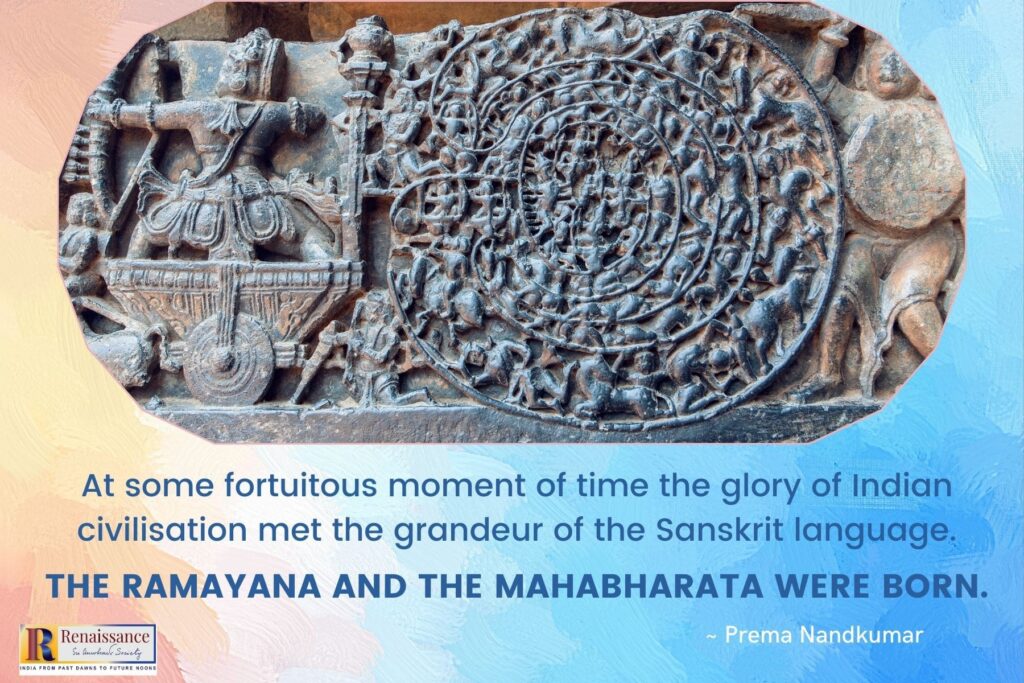
Indians of ancient times: were they living like the “amritasya putrah”, children of immortality? Did the native spiritual view affect the kings and commoners alike? What were the heights they managed to attain? How strong the asuric forces, how detestable the kingdoms and godheads of little mind? Where were the pockets that contained the mothers of evil and the children of darkness?
Looking at the life around them, the poets began to indite upakhyanas, stories based on the civilisation of which they too were a part. Presently the epic genius seized the Indian mind. The Sanskrit language which had echoed lyrically the subtle spaces of spiritual attainments by the Vedic seers later gathered the conversational crispness needed for a meaningful dialogue between the teacher and the taught.
With the emergence of the Heroic Age, the language too grew in strength, collecting an appropriate vocabulary, perfecting a virile grammar and spreading the rainbow-colours of imaginative exuberance. Comparing this Sanskrit with Bengali in India and French in Europe, Sri Aurobindo remarked that it was natural to have great epic poets like Valmiki, Vyasa and Kalidasa in Sanskrit for “the very language is epic” unlike the other two which were “too lucid and orderly and graceful”. (3 January, 1939, Talks with Sri Aurobindo, ed. Nirodbaran, 1966, p. 153.)
At some fortuitous moment of time the glory of Indian civilisation met the grandeur of the Sanskrit language. The Ramayana and the Mahabharata were born.
Both the epics had grown out of India’s ancient culture. In their turn, they have been a source of inspiration, encouragement, pride and comfort for the Indians through the centuries.
Even today, every action on the Indian clime is viewed through the tinted glasses of the twin epics. The ideals of the Rama Rajya and the scene of the Kurukshetra War enthused millions to take an active part in India’s independence movement, for, great leaders like Sri Aurobindo, Bal Gangadhar Tilak, Subramania Bharati and Mahatma Gandhi used these images in their speeches and writings quite often. The infights in politics, the problem of poverty and the moral-ethical prerogatives in the social system were often analysed in terms of the actions and the characters found in the two epics. Sri Aurobindo himself used parallel situations and names from the epics in his political articles.1
The call of the epics never fails to touch sympathetic chords in the Indian psyche. For instance, as recently as 1983, a political party, hardly a few months old, won an absolute majority in the Andhra Pradesh Legislature by splashing in advertisements and echoing through cassettes the assurance given by Krishna in the Bhagavad Gita:
“Whensoever, O Bharata, there is the fading and crisis of the Dharma and the uprising of unrighteousness, adharma, then I loose myself forth (into birth). For the deliverance of the good and the virtuous, for the destruction of the evildoers, for the enthroning of the Right (Dharma) I am born from age to age.”
~ Bhagavad Gita in the Light of Sri Aurobindo (Ed. Maheshwar), p. 64.
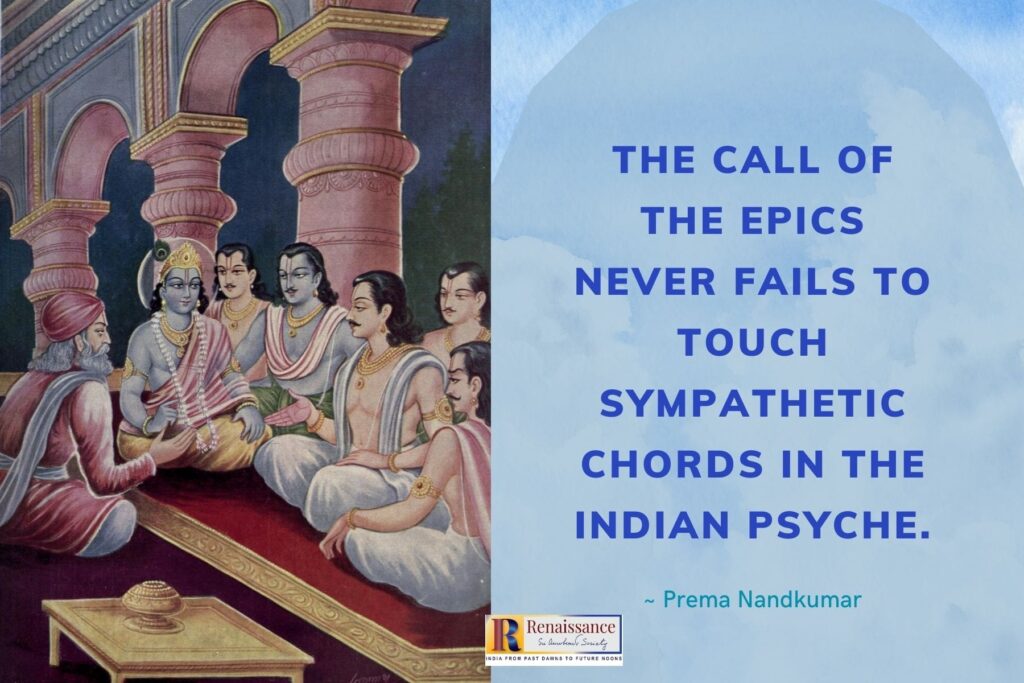
From Greece to India
However, the early literary foundations of the author of The Foundations of Indian Culture were wholly Greek and Latin and the culture of the Occident. As a boy not yet seven, Sri Aurobindo was given a good grounding in Latin by Mr. Drewett. This helped him enter St. Paul’s School and very soon he became a scholar in Greek and Latin.
Soon after, he won a classical scholarship at King’s College, Cambridge. Translating Greek and Latin verses became an interesting pastime, and one such piece, “Hecuba”, received praise from the scholar-poet, Laurence Binyon. Sri Aurobindo won the Rawley prize for Greek iambics in King’s College, and scored record marks in Greek and Latin in the I.C.S. examination. His conversations contained enthusiastic references to Greek literature. (See A. B. Purani, Life of Sri Aurobindo, 1960, pp. 48-9).
His first volume of verse, Songs to Myrtilla was the fruit of his overwhelming involvement with the Greek muse. At the close of Songs to Myrtilla is the poem, ‘Envoi’. He may have meant it to be a formal good-bye as he was returning to India soon. But the few lines turned out to be prophetic as far as his literary career was concerned.
For in Sicilian olive-groves no more
Or seldom must my footprints now be seen,
Nor tread Athenian lanes, nor yet explore
Parnassus or thy voiceful shores, O Hippocrene.
Me from her lotus heaven Saraswati
Has called to regions of eternal snow
And Ganges pacing to the southern sea,
Ganges upon whose shores the flowers of Eden blow.
~ CWSA, Vol. 2, p. 37
Thus when Sri Aurobindo entered the Baroda State Service, he was a total stranger to Indian language except a little Bengali which he had had to learn as an I.C.S. probationer who had opted for service in Bengal. His teacher was an Englishman who himself knew very little of the language.
At Baroda, Sri Aurobindo first made arrangements to improve his Bengali. Marathi and Gujarati too invited his attention as the languages were current in Baroda. And as a classical scholar who had mastered Greek and Latin, he was attracted to Sanskrit. Sanskrit brought him a tremendous revelation. To one who had been an enthusiastic admirer of the Athenian civilisation, the culture unveiled by the Sanskrit heritage through Valmiki, Vyasa, Kalidasa and Bhartrihari appeared altogether unique.
Though apparently older than the Greece of his classical studies, this was a brave new world; it mirrored a beauteous mankind that had attained perfection in several spheres and had based its civilisation on foundations that were aesthetically pleasing and spiritually noble.
Yes, this was quite different from the Greek past that Sri Aurobindo had hitherto known. The glory that was Greece, its heroes and heroic battles, gods and titans, were all frozen within the parchments of a few epics, dramas and histories. Greece was no longer a living influence. The gods had departed from the hearths and temples, from art and poetry. A solitary poem like Keats’ ‘Ode to a Grecian Urn’ was itself a commentary upon this irrevocable passing of the Greek past.
. . . thy streets for evermore
Will silent be; and not a soul to tell
Why thou art desolate, can e’er return.
Not so the Indian past. Sri Aurobindo found that what belonged to the yesterdays of Indian culture remained relevant and active even on the day when he was reading and writing.
The stories of Rama and the Pandavas were part of the day- to-day life of the Indians. The anecdotes and poetry of the epics were remembered with effortless ease in the conversations of the common man. They still wept with Sita and Draupadi at the dramatic representations in country fairs.
Toru Dutt’s memorable poem ‘Sita’ recalls this perennial recreation of epic scenes by mothers telling stories to their children. Not a modern room, but it is Valmiki’s ashram that encloses the children as they listen and see before them the consort of Rama enveloped in gloom:
But who is this fair lady? Not in vain
She weeps, — for lo! at every tear she sheds
Tears from three pairs of young eyes fall amain,
And bowed in sorrow are the three young heads.
It is an old, old story, and the lay
Which has evoked sad Sita from the past
Is by a mother sung…
Introducing her Cradle Tales of Hinduism based mainly on the Ramayana and the Mahabharata legends, Sister Nivedita says:
“These two great works form together the outstanding educational agencies of Indian life. All over the country, in every province, especially during the winter season, audiences of Hindus and Mohammedans gather round the Brahmin story-teller at nightfall, and listen to his rendering of the ancient tales. The Mohammedans of Bengal have their own version of the Mahabharata. And in the life of every child amongst the Hindu higher castes, there comes a time when, evening after evening, hour after hour, his grandmother pours into his ears these memories of old.
“There are simple forms of village-drama, also, by whose means, in some provinces, every man grows up with a full and authoritative knowledge of the Mahabharata.”
~ 1972 edition, p. vi
Parents wished their sons to be obedient as Rama; and their daughters to be as chaste as Savitri. This remarkable endurance of the legendary characters was no doubt due to the basic spiritual strength garnered in the epic past.
Also see:
Ramayana and the Cultural Mind of India
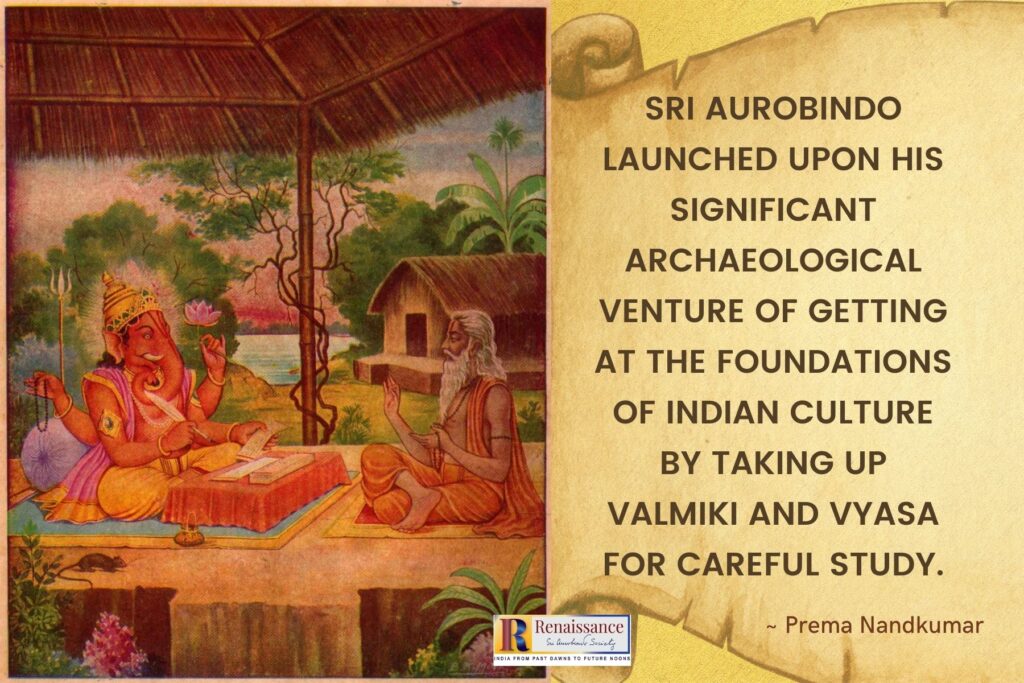
What was then the secret of these Indian epics that they had been “received and absorbed by both the high and the low, the cultured and the masses and remained through twenty centuries an intimate and formative part of the life of the whole nation?” (CWSA, Vol. 20, p. 353)
Sri Aurobindo launched upon his significant archaeological venture of getting at the foundations of Indian culture by taking up Valmiki and Vyasa for careful study. The more he delved into the Sanskrit epics, greater grew the distance between Greece and himself.
For instance, his political journalism began to reflect his Sanskrit studies in a large measure. ‘The Life of Nationalism’, an article written for the Bande Mataram makes magnificent use of Krishna’s birth in the prison at Mathura, his secret growth in Gokula and his destruction of Kamsa and assuming the leadership at Dwaraka to suggest the stages in the growth of the idea of Nationalism.
“Last is the season of rule and fulfilment, the life of Krishna at Dwaraka, when the victorious idea lives out its potent and unhindered existence, works its will with a world which has become in its hands as clay in the hands of the potter, creates what it has to create, teaches what it has to teach, until its own time comes and with the arrow of Age, the hunter, in its heel, it gives up its body and returns to the great source of all power and energy from which it came.”
~ CWSA, Vol. 7, p. 745
The Greek influence was, of course, never completely shaken off. Even after his retirement at Pondicherry, Sri Aurobindo did experiment with classical Western prosody, revised Perseus the Deliverer and began writing Ilion, a wholly Greek epic which was, however, left unfinished.
After meeting Valmiki and Vyasa, he never parted from their company.
Savitri, quarried from the Mahabharata was still in the process of composition, when he attained Mahasamadhi in 1950. It is quite possible that he may have wished to translate the twin epics into English (K. R. Srinivasa Iyengar, Sri Aurobindo: A Biography and a History, 1972, p. 143). He did render into English some chosen passages from Vyasa and Valmiki during his Baroda days.
The ‘Notes’ and the experiments in translation were his first soundings in the oceanic vastness of the two epics. Other interests — politics, poetry, political journalism, yoga, Yogashram — must have gradually pushed the original intention out of the field of actual execution. But the specimens that remain — even if they are no more than ‘drafts’ — are certainly suggestive of the great unfulfilled possibilities.” (Iyengar, p. 143-144).
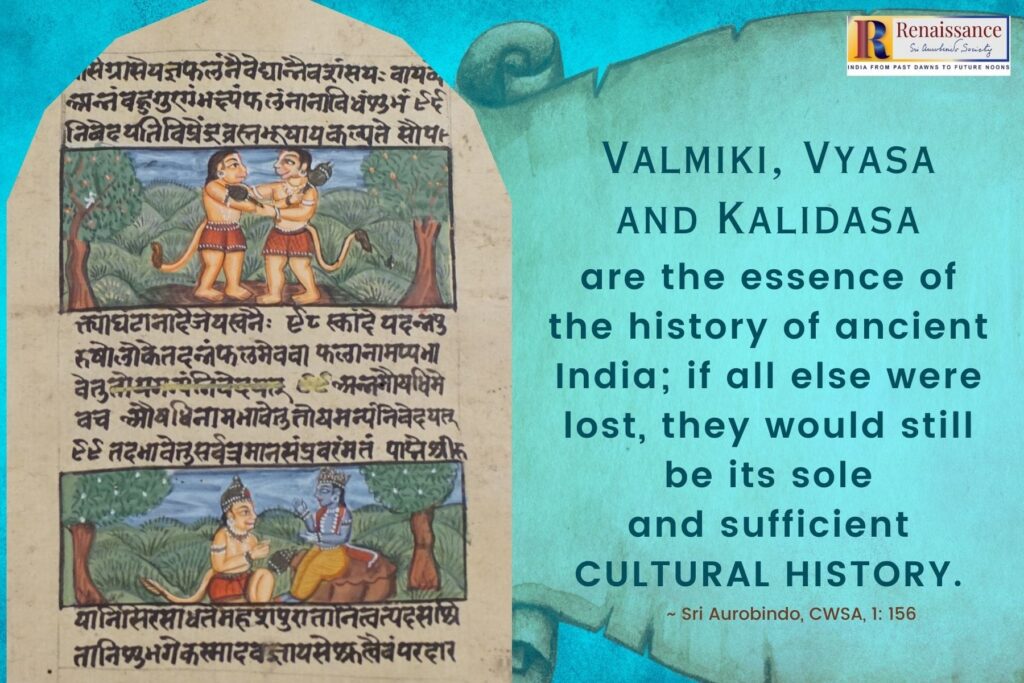
Notes
- An example from one of Sri Aurobindo’s articles in Karmayogin, titled ‘Exit Bibhishan’ – “He [Gokhale] publishes himself now as the righteous Bibhishan who, with the Sugrives, Angads and Hanumans of Madras and Allahabad, has gone to join the Avatar of Radical absolutism in the India Office, and ourselves as the Rakshasa to be destroyed by this new Holy Alliance. Even this formidable conjunction does not alarm us. At any rate Bibhishan has gone out of Lanka, and Bibhishans are always more dangerous there than in the camp of the adversary.” (CWSA, Vol. 8, p. 121) ↩︎

Continued in Part 2

~ Design: Beloo Mehra

